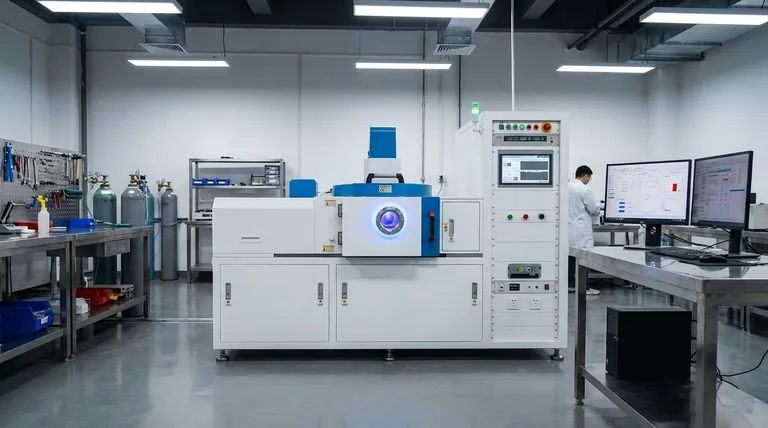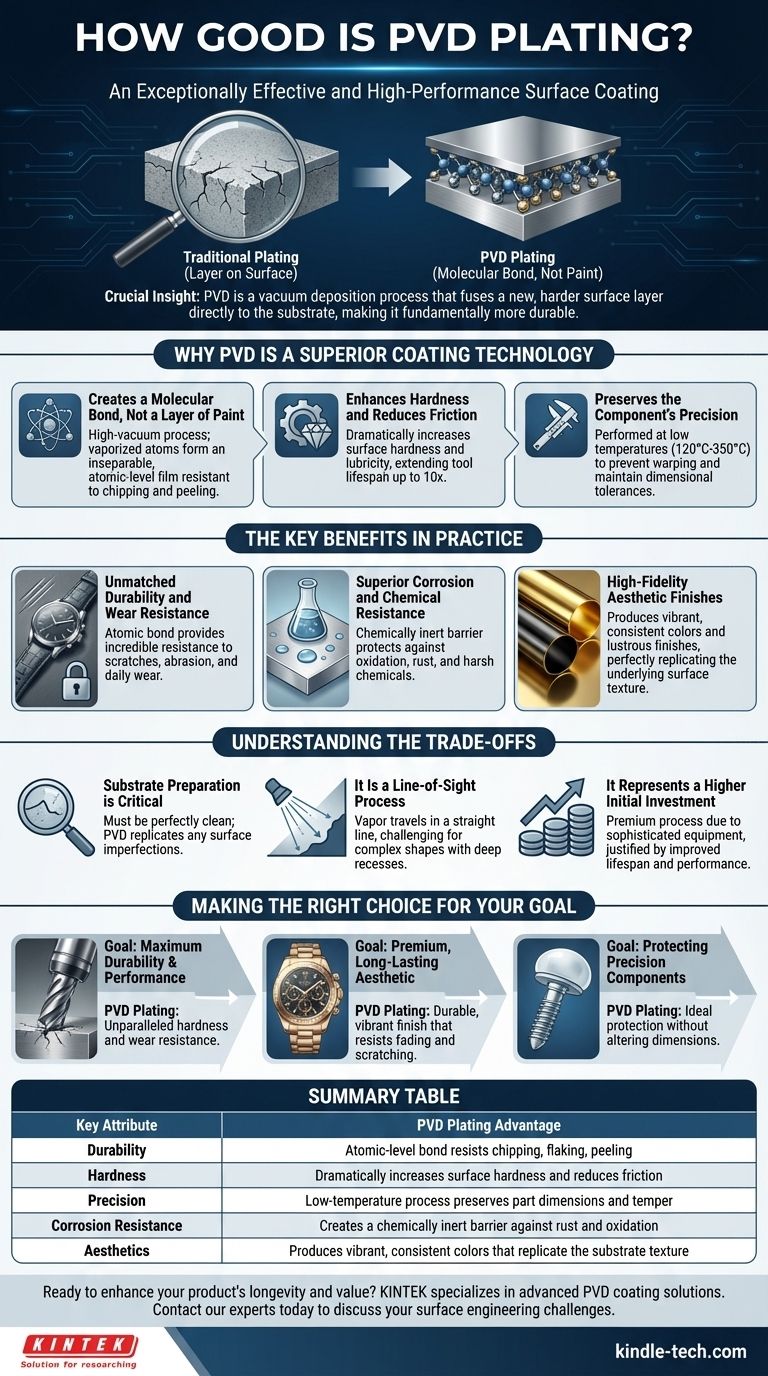PVD plating is an exceptionally effective and high-performance surface coating. Widely regarded for its remarkable durability, it creates a thin, bonded layer at the molecular level that significantly enhances a material's wear resistance, corrosion resistance, and aesthetic appearance without altering its fundamental shape or dimensions.
The crucial insight is that PVD is not simply a coating that sits on top of a surface; it is a vacuum deposition process that fuses a new, harder surface layer directly to the substrate. This makes it fundamentally more durable and resilient than traditional plating methods.

Why PVD is a Superior Coating Technology
PVD, or Physical Vapor Deposition, is a sophisticated process that provides benefits far beyond a simple surface finish. It fundamentally changes the properties of the substrate's surface for the better.
It Creates a Molecular Bond, Not a Layer of Paint
The PVD process takes place in a high-vacuum chamber where a solid coating material is vaporized into a plasma of atoms or molecules. This plasma is then deposited onto the target object, creating a bonded, atomic-level film that is inseparable from the base material. This is why PVD coatings are highly resistant to chipping, flaking, or peeling.
It Enhances Hardness and Reduces Friction
One of the primary benefits of PVD is a dramatic increase in surface hardness and lubricity (reduced friction). This makes it ideal for high-wear applications, such as cutting tools, where a PVD coating can extend the tool's effective lifespan by up to 10 times.
It Preserves the Component’s Precision
The PVD process is performed at relatively low temperatures (typically 120°C-350°C). This ensures that precision-engineered parts do not warp, lose their temper, or fall out of their dimensional tolerances—a critical advantage for aerospace, medical, and automotive components.
The Key Benefits in Practice
The technical advantages of PVD translate directly into tangible, real-world benefits across numerous industries.
Unmatched Durability and Wear Resistance
Because the coating is bonded at an atomic level, it provides a surface that is incredibly resistant to scratches, abrasion, and daily wear. This makes it a preferred choice for products that are handled frequently, from watch bands and jewelry to door hardware and firearms.
Superior Corrosion and Chemical Resistance
The PVD layer acts as a chemically inert barrier, protecting the underlying material from oxidation, rust, and damage from harsh chemicals. This ensures the product maintains its integrity and appearance even in challenging environments.
High-Fidelity Aesthetic Finishes
PVD can produce a wide range of vibrant, consistent colors and lustrous finishes, from deep blacks to brilliant golds. Critically, it perfectly replicates the underlying surface texture, meaning a brushed substrate will result in a brushed PVD finish, and a polished surface will yield a mirror-like PVD finish.
Understanding the Trade-offs
While PVD is a superior process, its technical nature introduces certain considerations. Objectivity requires acknowledging these factors.
Substrate Preparation is Critical
The PVD process is so precise that it will replicate any imperfections on the substrate's surface. The base material must be perfectly clean and free of any flaws, scratches, or contaminants to achieve a flawless final finish.
It Is a Line-of-Sight Process
In its basic form, the vaporized coating material travels in a straight line. This can make it challenging to evenly coat complex shapes with deep recesses or internal channels without specialized equipment and careful part rotation within the vacuum chamber.
It Represents a Higher Initial Investment
The sophisticated equipment and controlled environment required for PVD mean it is often a more premium process compared to simpler methods like painting or electroplating. However, this cost is frequently justified by the vastly improved product lifespan and performance.
Making the Right Choice for Your Goal
PVD is not a one-size-fits-all solution, but it is the definitive choice for applications where performance and durability are paramount.
- If your primary focus is maximum durability and performance: For cutting tools, medical instruments, or engine components, PVD's hardness and wear resistance are unparalleled.
- If your primary focus is a premium, long-lasting aesthetic: For luxury goods, high-end electronics, or architectural fixtures, PVD provides a durable, vibrant finish that resists fading and scratching.
- If your primary focus is protecting precision components: For parts with tight tolerances that cannot be exposed to high heat, PVD is the ideal choice to add protection without altering dimensions.
Ultimately, choosing PVD is a strategic investment in a product's longevity, performance, and perceived value.
Summary Table:
| Key Attribute | PVD Plating Advantage |
|---|---|
| Durability | Atomic-level bond resists chipping, flaking, and peeling |
| Hardness | Dramatically increases surface hardness and reduces friction |
| Precision | Low-temperature process preserves part dimensions and temper |
| Corrosion Resistance | Creates a chemically inert barrier against rust and oxidation |
| Aesthetics | Produces vibrant, consistent colors that replicate the substrate texture |
Ready to enhance your product's longevity and value with PVD plating?
KINTEK specializes in advanced PVD coating solutions for a wide range of industries, including aerospace, medical, automotive, and luxury goods. Our expertise ensures your components receive a durable, high-performance finish that protects precision and enhances aesthetics.
Contact our experts today to discuss how our PVD services can solve your specific surface engineering challenges and deliver a superior return on investment.
Visual Guide

Related Products
- RF PECVD System Radio Frequency Plasma-Enhanced Chemical Vapor Deposition RF PECVD
- Chemical Vapor Deposition CVD Equipment System Chamber Slide PECVD Tube Furnace with Liquid Gasifier PECVD Machine
- Split Chamber CVD Tube Furnace with Vacuum Station Chemical Vapor Deposition System Equipment Machine
- Aluminized Ceramic Evaporation Boat for Thin Film Deposition
- 1400℃ Controlled Atmosphere Furnace with Nitrogen and Inert Atmosphere
People Also Ask
- How are PECVD and CVD different? A Guide to Choosing the Right Thin-Film Deposition Process
- Why does PECVD commonly use RF power input? For Precise Low-Temperature Thin Film Deposition
- What are the advantages of PECVD? Enable Low-Temperature, High-Quality Thin-Film Deposition
- What is an example of PECVD? RF-PECVD for High-Quality Thin Film Deposition
- What are the applications of PECVD? Essential for Semiconductors, MEMS, and Solar Cells



















